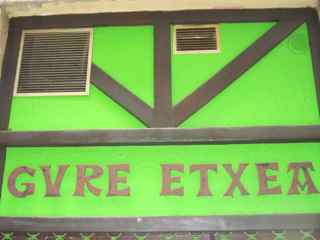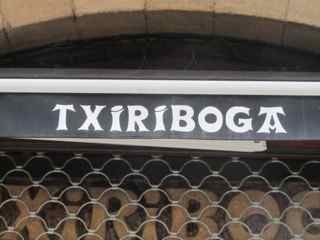I have huge amounts to blog about and lots of pictures to post, and not much time at present, so I am storing most of it up for future posts. But here are some thoughts about the language situation, and some related pictures.
It’s a bit like the dual-language situation in parts of Wales, Ireland and Scotland. Everyone speaks Spanish, and some people speak Basque/Euskara, and all public information, shop signs, etc., are in both. As yet, we’ve not heard anyone actually speaking Euskara, however – I suspect you’d have to go into the rural villages for that. Wikipedia says that only about 50% of the inhabitants of the Basque Country actually speak Euskara, and most of those are in the under-24 age group, since they are the ones learning it in school.
The exception to all that is the word for ‘goodbye’. The Euskara word ‘agur’ seems to be the standard word for saying goodbye here, rather than the Spanish ‘hasta luego’. (We also hear local people using colloquial / familiar combinations like ‘Venga! Vale! Agur’! quite a lot, which seems to mean something like ‘ok – all right – see you’. )
Pietro’s boss here, who is Italian and whose wife is English, has two small children who are completely quadrilingual. They speak Italian to Dad, English to Mum, and both Spanish and Euskara at school. Marvellous.
Euskara is quite quite different! It’s a language isolate – unrelated (in any obvious way) to any other languages in Europe, or indeed anywhere else. It is assumed to be the only remnant of the languages spoken by the peoples who lived in Europe before the Indo-Europeans (Celts, Germans, Romans, etc.) got here. There are no clues whatsoever – so it’s a bit like encountering Hungarian or Finnish. Basic knowledge of Romance, Germanic or Slavic languages doesn’t help.
We’re getting a good sense of what it looks like – lots of ‘k’s, ‘x’s, ‘z’s and 'tx's – all very picturesque! Below are some pictures of café, bar and shop signs from the streets around us. You’ll see what I mean. It’s particularly picturesque because most of the signs are printed in a distinctive and rather pleasingly chunky Basque font which is apparently very ancient – deriving from stone-carving traditions during the Roman era – and strongly associated with the revival of Basque nationalism in the 1930s.
Pietro has started reading a book in Spanish called ‘Euskara para Dummies’. (Typical – not only is he learning Basque, but learning it in Spanish, a language he seems to be able to speak fluently despite never having learnt it. Makes you sick.). Apparently, it (Euskara) is a really very complicated language with all kinds of strange grammatical arrangements involving doing unusual compound things with subjects, objects, pronouns and verbs.
Even though the language is only spoken by 50% of the people, the population does seem to be very much genetically Basque. The Basques are quite distinctive in their looks – tending to be tall-ish, lean-ish, dark-haired, long-faced, long-nosed, and – well – in possession of very large earlobes! (According to Mark Kurlanksy in his 'Basque History of the World' (which I'm just starting to read), a derogatory Basque word for foreigners is ‘belarri motxari’ – the stumpy-eared ones!)
There are lots of things I’m not clear about yet, such as the details of the history of Basque nationalism, what goes on in schools, etc., etc. Kurlanksy's book apparently has all the answers. I’m picking up a few choice facts here and there but haven’t got anywhere near the full picture yet. Watch this space.
As for Spanish… well I’m now very proficient at ordering coffees and water, have just about learnt to count, and am beginning to able to understand when people in shops tell me how much things cost. Apart from that, I’m collecting lots of nouns but don’t know anything much about verbs yet. Very soon, I expect to be as bad at Spanish as I am at Italian.
Now, back to work.












 RSS Feed
RSS Feed